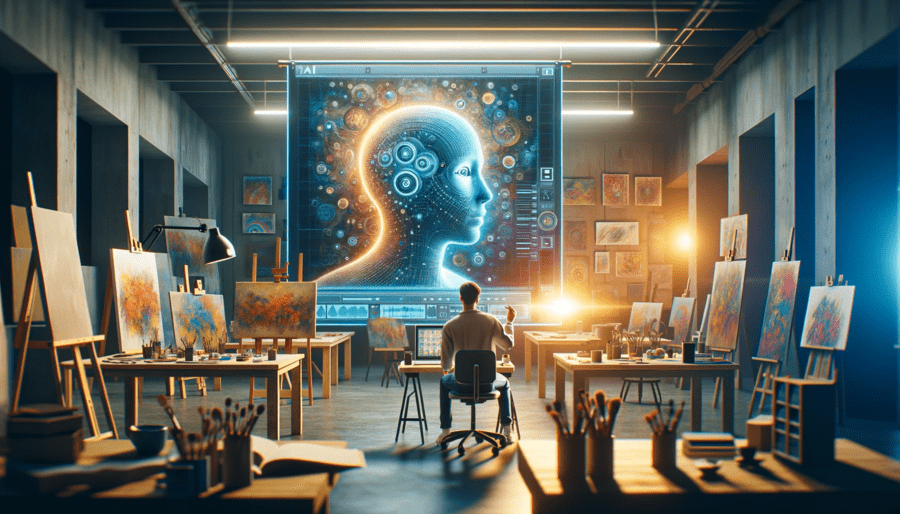Definition of Artificial Intelligence (AI)
The ambition of Artificial Intelligence (AI) is to create systems that can perform operations for which we usually rely on the human intellect.
This includes aspects such as image generation (yes, machines are learning to create fine arts!), image interpretation, visual pattern detection, and advanced decision-making processes.
To make it more understandable, AI is the fascinating and slightly shocking practice of developing machines that operate as if they possessed our visual creation capability.
Let's see how AI is changing the art landscape
The history of AI-generated art dates back several decades, with experiments by artists and computer scientists using computers to generate art.
Today, with the advent of deep learning techniques such as neural networks, AI-generated art has reached new levels of complexity and beauty.
A particular technique, known as Generative Adversarial Networks (GANs), has produced some of the most astonishing works of art in recent years.
These neural networks compete with each other to continuously create and improve their creations, giving rise to increasingly fascinating works of art.
The results have been astounding, with AI-generated art ranging from reinterpretations of classic works to completely original creations.
This has led to new forms of art, some of which might have been considered unimaginable just a few years ago.
But let's get to the heart of the article.
Let's see how to create Images with Artificial Intelligence: a brief guide to the Best Online Platforms and Mobile Apps
Creating images through artificial intelligence has become an increasingly widespread trend, allowing anyone to explore their creativity with ease and originality.
Here are some of the best online platforms and mobile apps that offer advanced artificial intelligence-based tools for creating unique images.
1. Midjourney: Exploring the Creative Journey of AI
Midjourney is a cutting-edge platform that offers advanced tools for AI-based image creation.
With an intuitive user interface, Midjourney allows users to experiment with unique artistic styles, transforming their photos into digital artworks.
The wide range of filters and styles available makes Midjourney an excellent choice for those looking to explore the creative journey of AI.
2. DALL·E: The Image Generation Revolution
DALL·E, created by OpenAI, has revolutionized the way we conceive image generation.
Based on generative model technology, DALL·E allows users to create astonishing images from textual descriptions.
With its ability to understand complex concepts and translate them into extraordinary images, DALL·E offers a unique and stimulating experience in visual creation.
3. Free Artificial Intelligence Online: Runway and Deep AI
Runway and Deep AI are two online platforms that offer free artificial intelligence services for image creation.
Runway offers a wide range of models ranging from painting in the style of van Gogh to transforming photos into abstract landscapes.
Deep AI, on the other hand, stands out for its ability to enhance image quality and apply advanced artistic filters.
4. Other Free Online Solutions: Exploring the Options
In addition to Runway and Deep AI, there are numerous other free online solutions for creating images with artificial intelligence.
- Canva — the popular platform for various graphic design projects also offers artificial intelligence-based image creation features such as text-to-image.
- Crayion — this interesting AI image generator, in addition to offering various styles, also allows specifying any features to be excluded in the final illustration.
- Jasper Art — this popular service can create 4 graphic contents at a time with AI by applying different styles and starting from less detailed descriptions. It can be tried for free for 14 days, after which a subscription with costs starting from $39 per month is required.
- Pixray — a free open-source platform that allows the user to create digital images by providing a description of their idea. It allows selecting different styles and applying extra settings through specific functionalities.
- Adobe Firefly — this is the AI system developed by Adobe, which can also be found integrated into Photoshop.
5. Creating Images with Artificial Intelligence on Smartphones and Tablets
a. AI Artistic Generator (Android/iOS):
This app offers a wide range of artificial intelligence-based filters and artistic styles, allowing users to transform their photos with a creative touch.
b. Other Innovative Apps:
Exploring the world of apps for image generation with artificial intelligence on smartphones and tablets can be a fun way to experiment with new levels of creativity on the go.
In conclusion, creating images with artificial intelligence is opening new horizons in the field of digital creativity.
With advanced online platforms and innovative mobile apps, anyone can become a digital artist, exploring new ways to express their creative vision.
The Issue of Intellectual Property
Who owns AI-generated art?
The human artist who programmed the AI, the AI itself, or both? These are complex questions that society has yet to answer.
There are also challenges and controversies regarding the use of AI in art.
Some fear that AI may replace human artists, while others argue that AI can only enrich the artistic landscape by offering new techniques and approaches.
Despite these challenges, emerging trends suggest that AI will play an increasingly important role in art.
With the evolution of AI technologies, we can expect to see increasingly astonishing and innovative works of art.
In conclusion, AI has already begun to change the art landscape in surprising and often wonderful ways.
Despite the challenges and controversies, the importance of AI in generating artistic content cannot be underestimated. We are only at the beginning of this artistic revolution and look forward to seeing what the future holds; the relationship between AI and art is complex and multidimensional. AI has the power to transform the field of art, creating new possibilities and challenges.
But like any new technology, it is important to carefully consider how we are using it and what the future implications might be.
